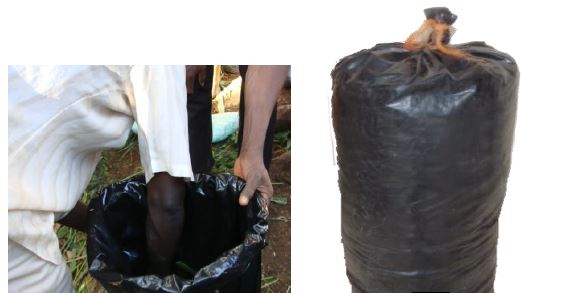The polythene bag silage method is ideal for smallholder farmers who can make small quantities of silage alongside other chores on the farm. (Pic: KALRO)
Smallholder dairy farmers in Kenya mainly depend on forages to feed livestock. Forage production is rain-fed; therefore, feed is plenty during the rainy season and scarce during the dry season. Dairy productivity is therefore low in the dry season mainly due to inadequate and low quality forage.
Preservation of surplus fodder has the potential for increasing or stabilizing milk production in smallholder dairy farms.
According to a research published by the Kenya Agricultural and Livestock Organization, cassava-based silage technology using polythene bags is an option for providing high quality feed for the dry season.
It offers potential for feed availability through the use of cassava by products (unmarketable cassava roots and leaves), which are not used for human consumption and would otherwise go to waste. The cassava based silage technology is new in coastal Kenya, hence the need for its up- and out- scaling in the region.
The polythene bag method is a technology of making small quantities of silage in polythene bags. It is ideal for smallholder farmers who can make small quantities of silage alongside other chores on the farm.
The materials required:
- Napier grass
- Cassava leaves
- Polythene bags gauge 800, size 23 inch width. Heavy gauge recycled bags without holes can be used
- Fresh or dry cassava chips
READ ALSO: Sweet potato vines and roots silage offers livestock more proteins
READ ALSO: Molasses secures livestock silage for over a year for farmers
READ ALSO: Farmers make silage from sweet potato vines
Preparation of materials:
- Cut Napier grass 75-100 cm high or 4-6 weeks regrowth depending on weather conditions
- Harvest cassava leaves.
- Allow Napier grass and cassava foliage to stay in the sun for one day to wilt.
- Chop Napier grass to about 5 cm (2 inches) using a panga.
Filling the polythene bag
- Fill the polythene bag with forage mixture to 1/3 full.
- Sprinkle a layer of cassava chips. The forages can be mixed with cassava chips before filling the bag. The mixture should be in a ratio of 14:5:1 for Napier grass, cassava leaves and dry cassava chips, equivalent to 5:2:1 when fresh cassava chips are used. This is similar to the percentages used for pit silage.
- Press the mixture with hands to force out as much air as possible.
- Repeat the process until the bag is full leaving room for tying.
- Tie the bag with sisal twine or cotton thread.
- The fermentation process is complete in three weeks and the silage is ready for use.
Using silage made in polythene bag
- Open the bag to remove adequate feed for the animal for one day and cover the open end immediately.
- Feed after milking to avoid milk tainting.
- There is no difference in the quality of silage between dry and fresh cassava chips
Recommended feeding
Feed 10% of body weight (about 20-30 kg per animal) per day. The silage is used as the basal feed and a concentrate (commercial or home-made dairy meal) should be fed to lactating animals.

















Comments powered by CComment